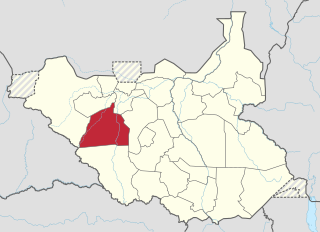Related Research Articles

Western Bahr el Ghazal is a state in South Sudan. It has an area of 93,900 km2 (36,255 sq mi) and is the least populous state in South Sudan, according to the controversial Sudanese census conducted in 2008. It is part of the Bahr el Ghazal region. Its capital is Wau. The state shared international borders with Sudan to the north and the Central African Republic to the west. The portion now occupied by Raga County is the southern part of the historical region known as "Dar Fertit".

Juba Arabic, also known since 2011 as South Sudanese Arabic, is a lingua franca spoken mainly in Equatoria Province in South Sudan, and derives its name from the South Sudanese capital, Juba. It is also spoken among communities of people from South Sudan living in towns in Sudan. The pidgin developed in the 19th century, among descendants of Sudanese soldiers, many of whom were recruited from southern Sudan. Residents of other large towns in South Sudan, notably Malakal and Wau, do not generally speak Juba Arabic, tending towards the use of Arabic closer to Sudanese Arabic, in addition to local languages. Reportedly, it is the most spoken language in South Sudan despite government attempts to discourage its use due to its association with past Arab colonization.
The Ndogo are an ethnic group from the South Sudan, part of the Fertit.
Avokaya is a Central Sudanic language spoken in southern South Sudan and parts of the Democratic Republic of Congo.
The Sere languages are a proposed family of Ubangian languages spoken in South Sudan and the Democratic Republic of the Congo. Several are endangered or extinct. The most populous Sere language is Ndogo of South Sudan, with about 30,000 speakers.
The Baale language, Baleesi or Baalesi is a Surmic language spoken by the Baale or Zilmamo people of Ethiopia, and by the Kachepo of South Sudan. It is a member of the Surmic cluster; the self-name of the language and the community is Suri, which is the same as that of the Suri language, evoking an ethnonym that embraces the Tirma, Chai, and Baale communities, although linguistically the languages of these communities are different. There are currently 9,000 native speakers of Baleesi, 5,000 in South Sudan and 4,100 in Ethiopia; almost all of these are monolingual.
Kresh, also known ambiguously as Gbaya, is a Central Sudanic language of South Sudan.
Moru is a Central Sudanic language spoken in South Sudan by the Moru people. Dialects are Agi, Andri, ’Bali’ba, Kadiro, also known as Lakama’di, Miza and Moruwa’di.
Bongo (Bungu), also known as Dor, is a Central Sudanic language spoken by the Bongo people in sparsely populated areas of Bahr al Ghazal in South Sudan.

South Sudan, officially the Republic of South Sudan, is a landlocked country in East Africa. It is bordered by Ethiopia, Sudan, Central African Republic, Democratic Republic of the Congo, Uganda and Kenya. Its population was estimated as 12,778,250 in 2019. Juba is the capital and largest city.

The culture of South Sudan encompasses the religions, languages, ethnic groups, foods, and other traditions of peoples of the modern state of South Sudan, as well as of the inhabitants of the historical regions of southern Sudan.
Belanda Viri is a Ubangian language of South Sudan.
Bai is a Ubangian language of South Sudan.
Kresh is a small language group of South Sudan. It is generally considered to be a branch of the Central Sudanic languages. Boyeldieu (2010) judges that this has yet to be demonstrated satisfactorily, but Starostin (2016) finds convincing evidence, and that its closest relative within that family appears to be Birri.
Mündü (Mondo) is a Ubangian language of South Sudan, with a few thousand speakers in the Democratic Republic of the Congo.
Baka is a Central Sudanic language of South Sudan, with the majority living in an area centered on Maridi, South Sudan, but also a couple thousand speakers in the DRC. It has consonants with trilled release such as and.
Keliko (Kaliko) is a Central Sudanic language of the Democratic Republic of the Congo and South Sudan.
Ligi Ndogo Soccer Club is a football club and youth academy based in Nairobi, Kenya. The senior team currently competes in the National Super League, the second tier of the Kenyan football league system. The club's name is Swahili for "little league".

Wau State was a state in South Sudan that existed between 2 October 2015 and 22 February 2020. It was located in the Bahr el Ghazal region, and was part of the former state of Western Bahr el Ghazal. Wau State bordered Aweil State, Gbudwe State, Gogrial State, Lol State, and Tonj State.

Wau County is a county in the former state of Western Bahr el Ghazal, South Sudan. Wau County was home to the state's capital, Wau. It is the most populous county in the state with over 232,910 people.
References
- ↑ Ndogo at Ethnologue (25th ed., 2022)

- ↑ "Village Assessment Survey". International Organization for Migration South Sudan. 2013.